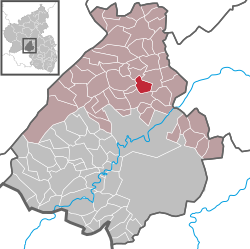|
Herrstein
   Herrstein is an Ortsgemeinde – a municipality belonging to a Verbandsgemeinde, a kind of collective municipality – in the Birkenfeld district in Rhineland-Palatinate, Germany. It is the seat of the Verbandsgemeinde Herrstein-Rhaunen. GeographyLocationThe municipality lies in the Hunsrück south of the Idar Forest on the Deutsche Edelsteinstraße (“German Gem Road”) in the Naheland, roughly 10 km north of Idar-Oberstein. The Fischbach flows through the village. Constituent communitiesAlso belonging to Herrstein are the outlying homesteads of Lindenhof, Steinäckerhof and Walkmühle.[3] HistoryHerrstein owes its beginnings to the crags at which a little stream called the Dietersbach emptied into the Fischbach, which seemed like a good place to build a castle to watch over the lordly holdings near Niederwörresbach, from which Herrstein was at first administered. At the foot of this stronghold on the so-called Herren-Stein (“Lord’s Stone”) arose a village, as so often happened when a castle was built in the Middle Ages. The castle and the village belonged then to the Counts of Sponheim, and Herrstein grew in importance as the seat of a Sponheim Oberamtmann The exact time when the village was first settled is lost in the mists of history, but on 9 April 1279, Herrstein had its first documentary mention along with a knight named Ruther von Heresteyn. The Count of Sponheim eventually granted this slowly developing village town and market rights in 1428, although there was still sometimes compulsory labour, and the townsmen were also obliged to do maintenance on the town wall. It is unknown whether these town fortifications arose before town rights were granted or only afterwards, but whatever the case, they only afforded the inhabitants protection from attack, and thereby also only offered any incentive to settle here, until firearms were developed. In the 17th and 18th centuries, they had rather the opposite effect to the originally intended one, provoking enemies’ attacks instead, for it was believed that the town must harbour considerable booty. It was the Herrsteiners themselves who actually knocked parts of their girding wall down in 1674 when the enemy was making his way through the country. Whether the wall was ever reconstructed and whether the second town gate planned in 1710 was ever built are things that are uncertain. What is known is that as early as the earlier half of the 18th century, the first house outside the town wall was built. Until that time, the only buildings there had been barns and buildings that had needed to be on the Fischbach, namely tanneries and mills. In 1792, during the French Revolutionary Wars and Napoleonic times, Herrstein lost its town rights. However, Herrstein has kept its function as an administrative centre of one kind or another until the present day; it is currently the Verbandsgemeinde seat. The Schinderhannesturm, a tower in Herrstein, gets its name from Schinderhannes (Johannes Bückler), Germany's most famous robber, who was locked up there for one night in 1798. Further growth in the 18th and 19th centuries was largely thwarted by the municipality's failure to undergo population growth as so many places did at this time. The only expansion in the 19th century was a new “ring road” outside the old town wall, which allowed some new houses to be built right onto the outside of the wall. The legacy of this time of meagre growth, however, had an unexpected advantage: nowhere else in the Nahe-Hunsrück area was there a mediaeval town that was so well preserved. Restoration on the old village centre began in 1971, including partial reconstruction of the town wall, most of which had been torn down to give the village growth room, and the result has been the driving force behind the village's tourism industry. Timber-frame houses that had had their framing plastered over or even covered with asbestos slabs were stripped to reveal their structure.[4] PoliticsMunicipal councilThe council is made up of 12 council members, who were elected by majority vote at the municipal election held on 7 June 2009, and the honorary mayor as chairman.[5] MayorHerrstein's mayor is Eberhard Weber.[6] Coat of armsThe German blazon reads: Über silbernem Schildfuß, darin ein blauer Dreiberg, von silbernem Faden gespalten, vorn blau-goldenes Schach, hinten rot-silbernes Schach. The municipality's arms might in English heraldic language be described thus: Per fess abased an endorse argent between chequy azure and Or and chequy gules and argent, and argent issuant from base a mount of three of the second. The two “chequy” fields in the arms are a reference to the village's former allegiance to the County of Sponheim. The composition is said to have been drawn from that in a court seal from the mid 17th century.[7] Culture and sightseeingBuildingsThe following are listed buildings or sites in Rhineland-Palatinate’s Directory of Cultural Monuments:[8]    
 Inhabitants’ nicknameHankel is a word that has been used as a nickname for Herrstein's inhabitants. It arose from the once locally common hyphenated forename “Johann-Karl”, which was elided to “Hann-Karl”, and then eventually to “Hankel”. Among the Hankels themselves, the term seems to mean a self-assured and usually also somewhat bigheaded member of the landed bourgeoisie. In the surrounding villages, though, the perception of the term rather differs. At the so-called Hankelbrunnen, a fountain in Herrstein, the adult figure represents the Hankel. That the Hankel was often exposed to the chaffing of his surrounding area is symbolized by the boy, who is squirting him with water. The figures were created by the artist Hans-Ulrich Pauly (Veitsrodt) after an idea by mayor Wolfgang Hey, and poured in 1983 by the Glocken- und Kunstgießerei Rincker, a foundry in Sinn that makes bells and artistic objects.[9] Regular events
Famous people
References
External linksWikimedia Commons has media related to Herrstein.
|
||||||||||||||||||||||||||||||||||||||||||||||||




